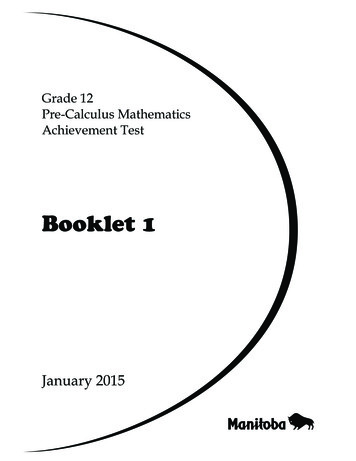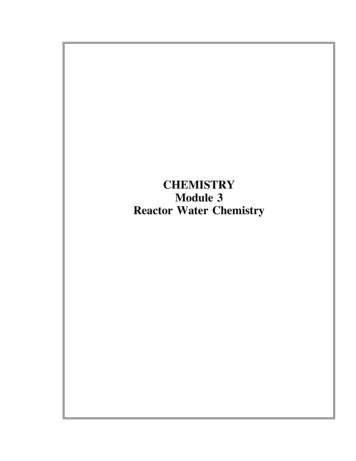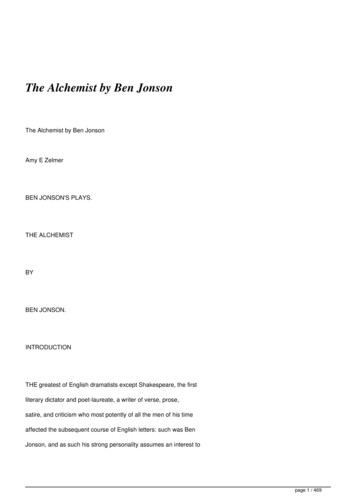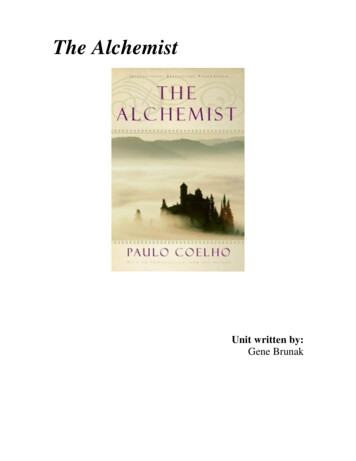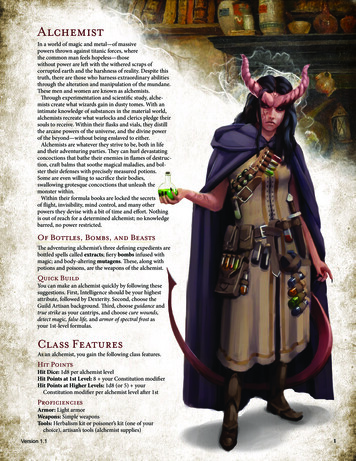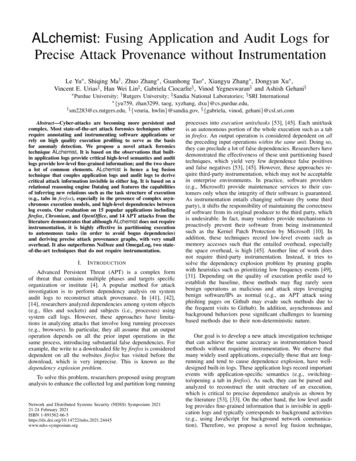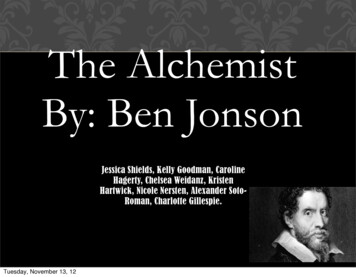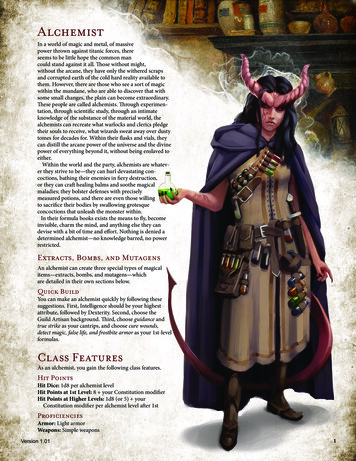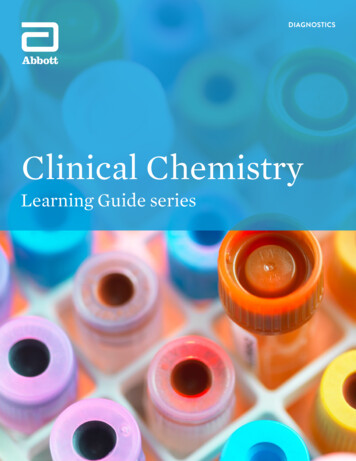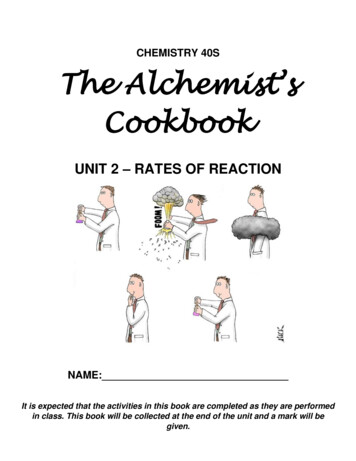
Transcription
CHEMISTRY 40SThe Alchemist’sCookbookUNIT 2 – RATES OF REACTIONNAME:It is expected that the activities in this book are completed as they are performedin class. This book will be collected at the end of the unit and a mark will begiven.
LET’S GET STARTED!By the end of this unit, you should be able to: Define rate of reaction as a change in quantity per unit of time. In chemistry, the standardunit of rate is molarity/second (mol/L.s) Calculate the rate of appearance of products and disappearance of reactants in mol/L.sfrom data obtained from experiment. Calculate the rate at which a product is formed from the rate at which a reactant is usedup using stoichiometric ratios. Plot molarity vs. time on a grid and use the resulting graph to determine the average rateand instantaneous rate of reaction from the slope of the lines. Identify 4 variables that influence the rate of a reaction and explain why they do usingcollision theory. Draw and analyze a potential energy diagram of an exothermic and an endothermicreaction. Formulate a rate law for a reaction from rate data obtained in the lab. Explain the concept of a reaction mechanism and evaluate possible mechanisms for agiven reaction.This unit will take approximately 13 lessons to complete and will comprise 10% of your markin this class.
ACTIVITY #1 – LAB: LET’S GET GASSY!Background:Chemists frequently need to know the rate at which a chemical reaction is creating product and the rate at whichit is using up reactant in order to monitor how the reaction is proceeding. This information can be obtained in avariety of ways. For instance, if a gas is produced in a closed container, then continuous monitoring of gaspressure indicates the rate. If a colour is produced or used up, monitoring of the colour intensity with a devicecalled a spectrophotometer indicates the rate. If a gas is produced and allowed to escape the system, thedecrease in mass over time indicates the rate. In this lab, we will use yet another method of monitoring the rateof a reaction involving gases is to measure the volume of gas produced by the displacement of water in aeudiometer (gas measuring tube).Household bleach is an aqueous solution of sodium hypochlorite (NaClO). Under normal conditions thehypochlorite ion (ClO-) slowly breaks down into chloride ions (Cl-) and oxygen gas (O2) according to thefollowing reaction:2ClO-(aq) 2Cl-(aq) O2(g)The reaction can be speeded up with the addition of something called a catalyst (we will learn more about thislater in the unit). In this activity, we will use a catalyst (cobalt(III) oxide) to speed up the reaction above andmeasure the volume of oxygen gas produced. We will then use this information to calculate the average rate ofthe reaction.Procedure:1. Refer to the diagram to set up your gas collectionapparatus.2. Fill the eudiometer with water and invert it into thetrough. Hold it in the vertical position with a clamp andring stand.3. Place the hose from the gas collection tube and stopperinto the neck of the eudiometer.4. Measure 15 mL of bleach solution into a 25 mL graduated cylinder and pour it into your Erlenmeyerflask.5. Measure 5 mL of 0.10 mol/L cobalt(III) nitrate solution into a 10 mL graduated cylinder.6. Pour the cobalt nitrate solution into the Erlenmeyer flask and IMMEDIATELY place the stopper andtube in the mouth of the flask. Start your stopwatch. Swirl the flask gently, continually, and at aconsistent rate.7. Record the total volume of oxygen gas collected every 30 seconds until a volume of 50 mL has beenobtained. Also record the total time it took to obtain 50 mL of oxygen.
Experimental Results:Time (s)30Volume of O2(g)Time (s)2106024090270120300150330180360Volume of O2(g)Total Time to Collect 50 mL of O2(g):Analysis of Results1. Plot a graph of your results on the sheet of graph paper on the following page. Plot volume of oxygenproduced vs time elapsed.2. Calculate the overall rate of production of oxygen by dividing the total volume of gas produced by thetotal time take to produce that amount. Identify and use the correct units for your rates.3. Bleach is made by the action of chlorine gas on sodium hydroxide:Cl2(g) OH-(aq) Cl-(aq) ClO-(aq) H2O(l)However, if an acid is added to the bleach, the process is reversed:Cl-(aq) ClO-(aq) 2H (aq) Cl2(g) H2O(l)Why should you never mix bleach with any cleaner or household product that is acidic?
ACTIVITY #2 – CALCULATING RATES FROM DATAAt 40oC, hydrogen chloride gas, HCl(g), will form from the reaction of gaseous hydrogen andchlorine according to the following balanced chemical equation:H2(g) Cl2(g) 2 HCl(g)The following table contains measurements made by a chemist during this reaction.Time (s)02.164.32H2(g)1.0000.5000.250Concentration of Chemicals alculate the following average rate changes for each reactant and product in mol/L.s. Use the formula forcalculating rate to determine the first column. Use mole ratios to determine the other two columns.Time (s)Rate of H2 Disappearance(mol/L.s)Rate of Cl2 Disappearance(mol/L.s)Rate of HCl Appearance(mol/L.s)0-2.162.16 – 4.321. What do you notice happens to the average rate disappearance/appearance of each of the substances overtime? Why do you think this happens?2. What relationship do you notice between the rate of disappearance of the reactants at any one time, andthe rate of appearance of the product during that same time?
ACTIVITY #3 – CALCULATING RATES FROM GRAPHSA chemist measured the concentration of two gases at various time intervals during the chemical reaction2NO2(g) N2O4(g). Her data is contained in the table below.Rate Data for the Reaction 2NO2(g) N2O4(g)Time 310.351. Construct a graph to represent this data. Plot gas concentration in mol/L on the y-axis and time inseconds on the x- axis (square brackets in chemistry refer to the molarity of that solution in mol/L). Useyour graph to answer the rest of the questions.2. Determine the instantaneous reaction rate in mol/L.s for each gas at 50 s. Show your tangent lines onthe graph.3. Determine the instantaneous reaction rate in mol/L.s for each gas at 200 s. Show your tangent lines onthe graph.4. Using your answers from the previous questions, complete the following statements:“As the reactants get used up, the rate of the reaction because.”“The rate at which the reactants are consumed in this reaction are the rate atwhich products are produced. This is because.”
ACTIVITY #4 – POTENTIAL ENERGY DIAGRAMS1.Draw the energy diagram showing the energy changes that occur during a successful collision of theexothermic reaction:H2 I2 2 HI 250 KJThe energy of the reactants 400 KJThe activation energy of the forward reaction 200 KJ2.Draw the energy diagram showing the energy changes that occur during a successful collision of theendothermic reaction:A B 200 KJ The energy of the reactants 200 KJThe activation energy in the forward direction 250 KJC
3. Write the following reaction in ΔH notation.a) A B 200 kJ b) 2AlBr3 3BaF2 C2AlF3 3BaBr2 276 kJ4. Write the following reaction in Standard Notation.a) H2 I2 b) 2NI3 3BaCl2 2 HI2NCl3ΔH -250 kJ 3BaI2ΔH 175 kJUse the following energy diagram to answer the rest of this page:5. How much potential energy is stored in the bondsof the reactant molecules?6. How much activation energy is required to allowthe reactant molecules to collide effectively?7. How much potential energy is stored in the bondsof the product molecules?8. Does the potential energy stored in the bonds of thechemical molecules involved in this reactionincrease or decrease as the reaction progresses?9. If potential energy is gained in a reaction, where does it come from? If potential energy is lost in areaction, where does it go?10. What is the change in enthalpy (H) of this reaction?11. Will the surroundings become hotter or colder as this reaction progresses? Why?12. Is this reaction endothermic or exothermic?
13. Draw the energy diagram that represents the following set of criteria:Potential energy reactants 250 kJ Potential energy activated complex 350 kJPotential energy products 300 kJa) What happens to the amount of energy stored in the chemical bonds (chemical potential energy) ofthe molecules as the reaction progresses?b) What happens to the amount of heat associated with this reaction (kinetic energy) as the reactionprogresses?c) Is the reaction exothermic or endothermic? How do you know?d) Will the surroundings become hotter or colder as this reaction progresses? Why?e) What is the value of ΔH?
14. Draw the energy diagram that represents the following set of criteria:Potential energy reactants 350 kJ Activation Energy 100 kJPotential energy products 250 kJa) What happens to the amount of energy stored in the chemical bonds (chemical potential energy) ofthe molecules as the reaction progresses?b) What happens to the amount of heat associated with this reaction (kinetic energy) as the reactionprogresses?c) Is the reaction exothermic or endothermic? How do you know?d) Will the surroundings become hotter or colder as this reaction progresses? Why?e) What is the value of ΔH?
15. Draw the energy diagram that represents the following set of criteria:Potential energy reactants 200 kJ Potential energy activated complex Potential energy products 150 kJ 400 kJa) What happens to the amount of energy stored in the chemical bonds (chemical potential energy) ofthe molecules as the reaction progresses?b) What happens to the amount of heat associated with this reaction (kinetic energy) as the reactionprogresses?c) Is the reaction exothermic or endothermic? How do you know?d) Will the surroundings become hotter or colder as this reaction progresses? Why?e) What is the value of ΔH?
ACTIVITY #5 – LAB: MINI-HINDENBURGSOverview:In this lab, you will react a sample of zinc with hydrochloric acid to generatehydrogen gas. You will use a balloon to capture the hydrogen that is generated. Atthe end of class, we will ignite these balloons to create some nice explosions. Thecentral concept you will be investigating in this lab is: What factors determine theSPEED of a reaction (the reaction rate)?Pre-Lab:Use the amazing cartoon below to think about the chemistry that is going to occur in your reactions. Use this toguide the decisions you make and the conclusions you draw from your results.1. Balance the equations below for the reactions you will perform. In each of these reactions, use oxidationnumbers to identify the substance being oxidized, the substance being reduced, and the spectatorions.Zn(s) HCl(aq) ZnCl2(aq) H2(g)2. The concepts listed below all affect the rate at which the reaction depicted above will occur. For eachconcept, jot down an idea for how/why this factor will affect the rate of the reaction. Remembercollision theory number of effective collisions determines rate. Effective collisions rely on collisionorientation and activation energy.a. The speed at which H (aq) swim through the aqueous medium.b. The number of Zn(s) atoms exposed to the acidc. The number of H (aq) available to react within the aqueous solution.
Procedure: (Put on eye protection and gloves immediately!)1. Obtain metals. Weigh out appropriate mass zinc metal from the designated supply beakers on the buffettable.Mass of Zn (should be between 1.80 g and 3.10 g)2. Take a beaker of acid from the buffet table and pour 20.0 mL of 6-molar HCl into your two Erlenmeyerreaction flasks.3. Drop your metal sample into the flask and immediately place a balloon atop the flask to capture the gasproduced.4. Using your pre-lab as a guide, INVENT AN EXPERIMENT with your partner for how to increase the zinc’sinitial reaction rate. When you think you have a good idea on how to speed up the zinc’s reaction,CONSULT WITH MR. WIEBE who will provide you with an instruction card to help you run yourexperiment with proper scientific controls. Perform your chosen experiment.5. As your reactions run, answer the questions below.6. 15 minutes before the end of the class period, VISUALLY ESTIMATE THE VOLUME of hydrogen collected ineach reaction by comparing the size of the balloons to objects of known volume, such as a 400 mLbeaker, a 1-liter cube, etc. Write these estimates in the proper spaces on question D.7. TERMINATE your reactions by REMOVING THE BALLOONS AND TYING THEM SHUT (don’t lose yourhydrogen gas when you do this!!!). Do this even if the reactions are not completed.8. Dump your leftover acid solutions into the waste beaker on the buffet table. Shake leftover bits of metalinto the trash (not in the sink!!!).9. At the end of the hour, your hydrogen-filled balloons will be ignited in a designated spot (Mr. WiebeMUST SUPERVISE the explosions). To ignite the balloons, you will need to hold your balloon withTONGS and bring the balloon into the flame of a Bunsen burner. EVERYONE MUST WEAR SAFETYGLASSES DURING THESE EXPLOSIONS!10. Help Mr. Wiebe CLEAN UP the mess made from the exploding balloons.Analysis:1. What did you change in your experiment? Why did you choose this change? Explain in terms ofcollision theory.2. What results did you observe? What conclusions can be drawn from your experiment?
ACTIVITY #6 – RATE LAW CALCULATIONSDetermine the rate law and rate constant for each of the following.1. H2O2 (g ) 2HI (g ) 2H 2 O ( g ) I 2 (g )Trial123[H2O2](M)0.10 M0.10 M0.20 M[HI](M)0.10 M0.20 M0.10 M)1.01.02.0Rate(M/h)1.30 x 10-35.20 x 10-34.16 x 10-22. 2NO ( g ) Br2 ( g ) 2NOBr ( g)Trial1233. ClO3 (aq) 9I (aq) 6H (aq) 3I 3 (aq) Cl (aq) 2H2 O ( l 00.200.20[H ](M)0.100.100.100.20Rate(M/s)0.51.02.08.0
4. The rate law of a reaction between gases Y and Z is found to berate k Y Z 2Change in Concentration:Change in Rate:Y is doubledY is tripledZ is quadrupledY is quadrupled while the concentration of Z isdoubledY is cut in half while the concentration of Z isdoubled.Y and Z are both tripled6. Consider the reaction: 2 NO(g) O2(g) 2 NO2(g)The following data were obtained from three experiments using the method of initial rates:Experiment 1Experiment 2Experiment 3Initial [NO](mol/L)0.0100.0200.010Initial [O2](mol/L)0.0100.0100.020Initial rate NO(mol/L)2.5 x 10-51.0 x 10-45.0 x 10-5a. Determine the order of the reaction for each reactant.b. Write the rate equation for the reaction.c. Calculate the rate constant.d. Calculate the rate (in mol/L.s) at the instant when [NO] 0.015 mol/L and [O2] 0.0050 mol/L
6. The reaction 2 NO(g) 2 H2(g) N2(g) 2 H2O(g) was studied at 904 C, and the data in the tablewere collected.Experiment 1Experiment 2Experiment 3Experiment 4Initial [NO](mol/L)0.4200.2100.2100.105Initial [H2](mol/L)0.1220.1220.2440.488Initial rate N2(mol/L)0.1360.03390.06780.0339a. Determine the order of the reaction for each reactant.b. Write the rate equation for the reaction.c. Calculate the rate constant at 904 C.d. Find the rate of appearance of N2 at the instant when [NO] 0.350 M and [H2] 0.205 M.
7. The reaction of tbutyl-bromide (CH3)3CBr with water is represented by the equation:(CH3)3CBr H2O (CH3)3COH HBrThe following data were obtained from three experiments using the method of initial rates:Experiment 1Experiment 2Experiment 3Initial [(CH3)3CBr](mol/L)5.0 x 10-25.0 x 10-21.0 x 10-1Initial [H2O](mol/L)2.0 x 10-24.0 x 10-24.0 x 10-2a. What is the order with respect to (CH3)3CBr and H2O?c. What is the overall order of the reaction?d. Write the rate equation.e. Calculate the rate constant, k, for the reaction.Initial rate(mol/L)2.0 x 10-62.0 x 10-64.0 x 10-6
ACTIVITY #7 – LAB: THE AMAZING IODINE CLOCK REACTIONWe know from past activities that changing the concentration of a reactant changes the initial rate of thereaction. We also know that there is a direct relationship between these two variables, as communicated by therate law of that reaction. In this experiment, a special reaction – called a clock reaction – will be used tomeasure changes in rate and concentration and determine the order of the reactants.The balanced net ionic equation for this reaction is:3 IO3-(aq) 8 HSO3-(aq) I3-(s) 8 SO42-(aq) 6 H (aq) H2O(l)Long story short, this reaction will continue until the HSO3-(aq) gets used up. When you see a blue-black colourappear, that signals that all the HSO3-(aq) has been consumed. You will measure the time it takes for thereaction to reach completion by timing the reaction from the first mixing to the appearance of the blue colour.Remember that average rate of a reaction can be determined by the following: 𝑎𝑔𝑒 𝑅𝑎𝑡𝑒 𝑡𝑖𝑚𝑒For this reaction specifically, the average rate can be determined as follows:1 [𝐻𝑆𝑂3 ] 1 [𝐼𝑂3 ]𝐴𝑣𝑒𝑟𝑎𝑔𝑒 𝑅𝑎𝑡𝑒 8 𝑡𝑖𝑚𝑒3 𝑡𝑖𝑚𝑒Since the HSO3-(aq) gets completely used up each trial and reaches 0 mol/L, the [HSO3-] [HSO3-] initial. Assuch, to calculate the average rate of the reaction in each flask, we can use the following equation:1 [𝐻𝑆𝑂3 ���𝑒 𝑅𝑎𝑡𝑒 8 𝑡𝑖𝑚𝑒The initial [HSO3-] needs to be calculated for each trial of the experiment because when solutions are mixed thebisulfite concentration is diluted initially. You can calculate the initial concentration using your formula fordilution.M1V1 M2V2where M molarity, V volume, 1 initial, and 2 final
Materials:Solution A: 0.020 M KIO3Solution B: 0.0080 M NaHSO3 in a solution containing starch and sulfuric acidObservations:Part 1: The Effect of Diluting HSO3- on the Reaction RateFlaskVolume of0.020 M KIO3Volume of Water-Volume of 0.0080M NaHSO3150.0 mL250.0 mL10.0 mL40.0 mL350.0 mL20.0 mL30.0 mL450.0 mL30.0 mL20.0 mL550.0 mL40.0 mL10.0 mLTime to React (s)50.0 mLPart 2: The Effect of Diluting IO3- on the Reaction RateFlaskVolume of0.020 M KIO3Volume of Water-Volume of 0.0080M NaHSO3150.0 mL50.0 mL240.0 mL10.0 mL50.0 mL330.0 mL20.0 mL50.0 mL420.0 mL30.0 mL50.0 mL510.0 mL40.0 mL50.0 mLAverage Time toReact (s)
AnalysisPART 1:FlaskInitial [HSO3-], MInitial [IO3-], MAverage Rate of Reaction(mol/L.s)Initial [HSO3-], MInitial [IO3-], MAverage Rate of Reaction(mol/L.s)12345PART 2:Flask123451. Calculate the initial concentrations of IO3-(aq) and HSO3-(aq) for each flask in both parts of the lab andrecord these values on the charts above. Remember, the final volume of the dilution will be thecombined volume of BOTH solutions after they are mixed. SHOW HERE your calculation of [HSO3-] inFlask #2 in Part 1 of the lab.
2. Calculate the reaction rate for each trial using the formula for average rate given earlier in the handoutand record these values in the charts above. SHOW HERE your calculation of average rate in Flask #2in Part 1 of the lab.3. Using the information in the chart for Part 1, calculate the order for HSO3-(aq).4. Using the information in the chart for Part 2, calculate the order for IO3-(aq).5. Using Part 1 Trial 1, calculate the k value for this reaction. Repeat this using Part 2 Trial 1. How do youranswers compare?6. Write the complete rate late for this clock reaction.7. Use your completed rate law to determine the rate of this reaction if you started with 0.050M HSO3- and0.0250M IO3-.8. Use collision theory to briefly explain how and why increasing concentration of reactants affects rate ofreaction. Do your results in this experiment agree with collision theory?
ACTIVITY #8 – REACTION MECHANISMS1. Use the following mechanism to answer this question:Step 1: OCl- H2OStep 2: HOCl IStep 3: HOI OH- HOCl OH HOI Cl H2O OI-a) The net chemical equation is:b) The reaction intermediates are:c) The catalyst is:2. Use the following mechanism to answer this question:Step 1: Br2Step 2: Br OCl2Step 3: Br Cl 2Br BrOCl Cl BrClslowfastfasta) The net chemical equation is:b) The reaction intermediates are:c) The catalyst is:d) The rate determining step is:e) The rate law is:f) If the concentration of Br2 is increased will the rate of the reaction increase? Explain your answer.g) If the concentration of OCl2 is increased will the rate of the reaction increase? Explain your answer.
3. Nitrogen monoxide reacts with hydrogen gas to produce nitrogen gas and water vapour. The mechanismis believed to be:Step 1:Step 2:Step 3:2 NON2O2 H2N2O H2 N2O2 N2O H2O N2 H2Oa) Determine the overall net equationb) Identify any reaction intermediatesc) Can you determine the rate law from this information? Why or why not?5. A proposed mechanism for a reaction is as followed:Step 1: O3(g) O2(g) O(g)Step 2: O3(g) O(g) 2O2(g)SlowFasta) Write the rate law equation expected for this mechanism.b) What is the overall net chemical equation for this mechanism?c) What is the intermediate in the mechanism?6. The steps of a proposed reaction mechanism for a reaction are:Step 1: NO(g) NO(g) N2O2(g)Step 2: N2O2(g) O2(g) 2NO2(g)a) What is the overall net chemical equation for this mechanism?b) What is/are the intermediate(s) in the proposed reaction mechanism?c) The rate law for this proposed mechanism was experimentally determined to be rate k[NO]2[O2].Based on this, which step in the mechanism is the rate determining step and why?
7. A proposed mechanism for a reaction is as follows:Step 1: C4H9Br(aq) C4H9 (aq) Br-(aq)Step 2: C4H9 (aq) H2O(l) C4H9OH2 (aq)Step 3: C4H9OH2 (aq) H2O(l) C4H9OH(aq) H3O (aq)slowfastfasta) Write the rate law expected for this reaction mechanism.b) What is the overall net chemical reaction for this mechanism?c) What are the intermediates in the proposed mechanism?8. A proposed mechanism for a reaction is as follows:Step 1: NH4 (aq) NH3(aq) H (aq)Step 2: H (aq) HNO2(aq) H2O(l) NO (aq)Step 3: NH3(aq) NO (aq) NH3NO (aq)Step 4: NH3NO (aq) N2(g) H2O(l) H (aq)slowfastfastfasta) What is the overall net chemical equation for this reaction mechanism?b) What are the intermediates for this mechanism?c) The rate law for this reaction was experimentally determined to be rate k[HNO2(aq)][NH4 (aq)]. Isthis reaction mechanism plausible? Support your answer.
ACTIVITY #9 – UNIT TEST REVIEW105.5 g of calcium reacts with 21.0 g of oxygen to produce calcium oxide, according to thefollowing reaction:2Ca(s) O2(g) 2CaO(s)1. The reaction takes 3 minutes and 35 seconds to reach completion. 52.9 g of calcium was left in thecontainer at the end. What was the average rate at which the calcium was used up? Provide youranswer in g/s and mol/min.2. List 4 things that could be done to speed up the rate of this reaction.Use the following data table to answer the next 3 questionsConcentrations of Reactant and Products Over Time for the Reaction 2NO2(g) 2NO(g) O2(g)Concentration (mol/L)Time 264. Calculate the average rate of disappearance of NO2 from 100 to 200 seconds5. Calculate the average rate of appearance of O2 from 100 to 200 seconds6. Use Collision Theory and the balanced chemical equation for this reaction to explain why youranswers to 4 & 5 are not the same.
7. Use the tangent line method to calculate the instantaneous rate of reaction in mol/L.h at both of thefollowing points:a) 30 mol/Lb) 10 mol/L8. Use Collision Theory to explain why the instantaneous rates at both points in time in question 7 arenot the same.9. Consider the combustion of propane, C3H8(g) 5 O2(g) 3 CO2(g) 4 H2O(g). If the rate ofdisappearance of O2(g) during a period is 6.4 mol/L·s, determine the rates of the following during thesame period.a. What is the rate of disappearance of C3H8(g)?b. What is the rate of appearance of CO2(g)?c. What is the rate of appearance of H2O(g)?
10. Use Kinetic Molecular Theory and Collision Theory to explain why and how the following changescauses the rate of a reaction to increase.Increasing ConcentrationIncreasing TemperatureAdding a CatalystIncreasing Surface AreaThe following is information about a chemical reaction. Use it to answer the following questions.Potential Energy of Reactant MoleculesChange in Potential Energy (Enthalpy)Activation Energy30 kJ/mol-20 kJ/mol40 kJ/mol11. Draw the PE curve on the grid provided.12. The potential energy stored in the molecules of theproducts is13. The activation energy to make the reaction occur inreverse is14. Use a dotted line (- - - - - - -) to sketch the diagram of acatalyzed version of the same reaction on the same grid.
15. Below is some initial rate data for the reaction, A B 2C.[A][B]Rate (mol/L·s)0.40 0.103.5 x 1030.20 0.101.8 x 1030.20 0.201.45 x 104a) Determine the orders of reactants A and Bb) Write the rate law for this reaction:c) Calculate the value of the rate constant, k.d) Calculate the rate of the reaction if [A] 0.50M and [B] 0.65M.16. Consider the following reaction:2NO 2H2 100kJ 2H2O N2Rate k[NO][H2]A proposed mechanism for the above reaction is:Step 1: NO H2 N H2OStep 2:?Step 3: N2O H2 N2 H2Oa) Write the equation for step 2 in the proposed mechanism.b) Which step is the rate determining step? How can you tell?c) Is this reaction endothermic or exothermic? How did you determine this?
17. Consider this reaction mechanism:HCOOH H2SO4 HCOOH2 HSO4HCOOH2 COH H2OCOH HSO4- CO H2SO4a) What is the overall reaction?b) List any “intermediates.”c) List any catalysts.d) If the first step is the slow step, what is the rate law?
The Alchemist’s Cookbook UNIT 2 – RATES OF REACTION NAME:_ It is expected that the activities in this book are completed as they are performed in class. This book will be c
